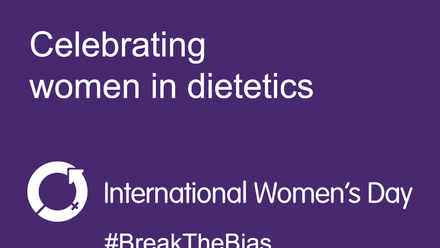The menopause is an ideal time to take stock of eating habits and begin some gradual changes to help ensure the best health possible while entering this new phase of life. Taking steps to achieve a healthy diet, a good level of fitness and an ideal body weight can help to ease immediate symptoms such as hot flushes, and improve longer term health, such as reducing risk of developing osteoporosis (brittle bones) and heart disease.
These tips should give you some easy ideas to get you started in the right direction.
From around your mid 30s you start to lose muscle mass. Muscle mass burns calories and so you can start to burn fewer calories over the day and begin the tendency to gain weight as you get older.
As you creep past 40 you may find you weigh more and your waist increases. Help minimise loss of muscle and stay strong by doing some strength exercise at least twice a week (such as circuit weights in the gym, squats, calf raises or using resistance bands at home) and watch your portion sizes.
Serve smaller portions of starchy foods, choose lean proteins and more vegetables or salad to help stop unwanted weight gain. Keep puddings and cakes as an occasional treat and choose fruit or low-fat dairy desserts instead. Watch out for the in-between meal nibbles, they may be tasty, but it’s easy to eat more than you realise.
Make time to eat regular meals
Eating regular meals, including breakfast, helps with weight control and may help to relieve some of the mood swings and fatigue that can come with the menopause. If you tend to snack then plan ahead and make healthier snacks rather than grabbing the first thing you see.
Prep veg sticks ahead to serve with salsa or tzatziki or prepare a bowl of chopped fruit to top with yoghurt and a sprinkle of nuts or buy small tubs of cottage cheese to top a couple of oatcakes.
Stay strong by doing some strength exercise at least twice a week and watch your portion sizes.
Choose fibre for great digestive health
Changing hormones of the menopause may increase any tendency towards sluggish digestion, bloating and constipation. Research tells us the best way to tackle this is to choose higher fibre foods and drink plenty of fluids. Wheat bran has been shown to be particularly effective at relieving digestive discomfort and constipation and some foods carry health claims to this effect.
Look for ‘high fibre’ or ‘bran’ on labels and check the nutrition panel. Foods with at least 3g/100g means they are a source of fibre or 6g/100g means they are a high fibre food. Fruit, vegetables, beans and pulses are great sources of fibre too.
Clue up on calcium
During the menopause the rate at which calcium is lost from bones speeds up dramatically as the protective effects of oestrogen are lost. This increases the risk of developing osteoporosis so boosting intake of both calcium and vitamin D is important.
Aim to include a low-fat dairy food (or calcium fortified plant alternative) in your diet three times a day (e.g. reduced fat milk on cereal, a skinny latte, low fat yoghurt or reduced fat cheese). In the UK all adults are advised to consider taking a 10mcg supplement of vitamin D daily, especially during the winter months.
Opt for omega-3s
Omega-3s are the type of fat found in oily types of fish (e.g. salmon, sardines, mackerel, herring, trout) and eating these once or twice a week can help to keep the heart healthy. In addition, omega-3s have been found to help improve mood - another great reason to try to eat oily types of fish regularly. Alternatively, you could consider taking an omega-3 rich supplement (now also available for vegetarians and vegans).
Help ease flushes with plant oestrogens
Plant oestrogens (also called phytoestrogens) are similar to human oestrogen. If eaten regularly, and in sufficient quantities, they can start to have mild oestrogen-like effects - which is useful as oestrogen levels decline. For some women these effects could be enough to help relieve menopausal symptoms, particularly hot flushes, but it can take two to three months for any benefits to be seen.
Consuming these several times a day appears to be more effective compared to one larger portion. Plant oestrogens seem to work better for some women than others which might be down to differences in gut bacteria.
Foods containing plant oestrogens (such as soya and linseeds) are also heart friendly so it’s worth trying to include calcium-enriched soya products like milk, yoghurts, soya and linseed breads or edamame beans into your diet two to three times a day for three months to see if these help you.
Check you are well hydrated
Many people don’t drink enough fluid and can be slightly dehydrated much of the time, increasing headaches and fatigue. Declining levels of oestrogen increase collagen loss and skin becomes thinner increasing signs of ageing and dryness. Eating well and staying well hydrated are two simple ways to boost skin health. If you are well hydrated your urine will be a pale straw colour - any darker than this and you need to drink more.
Fight the flushes
For many women specific things may trigger a hot flush such as hot drinks, alcohol, spicy food or curries. Other things such as strong emotions or external sources of heat (e.g. a hair dryer) may also trigger flushes. Try to work out your triggers and then cut these out or be prepared and dress in layers.
Eat 5 a day
Eating five portions of fruit and vegetables every day means that you are more likely to be getting enough fibre and the essential vitamins, minerals and antioxidants which are important during the menopause. On average we eat around three portions a day so for most of us there is still room for a little more.
One portion is equivalent to one whole apple or banana, a large slice of mango or pineapple, a couple of plums or satsumas, three heaped tablespoons of cooked vegetables, a side bowl of mixed salad or a bowl of vegetable soup.
Check out cholesterol
If you’ve never had a cholesterol test now is the time to ask for one from your GP. As oestrogen levels drop cholesterol can rise, increasing the risk of heart disease. Steps to help lower your cholesterol include cutting back on saturated fat (butter, fat on meat, pastry, cakes and biscuits) and replacing these with unsaturated fats such as olive oil and sunflower spreads.
Choose lower fat dairy foods, include fish (especially oily fish) twice each week, fill up on fibre and boost intake of fruit and vegetables.






